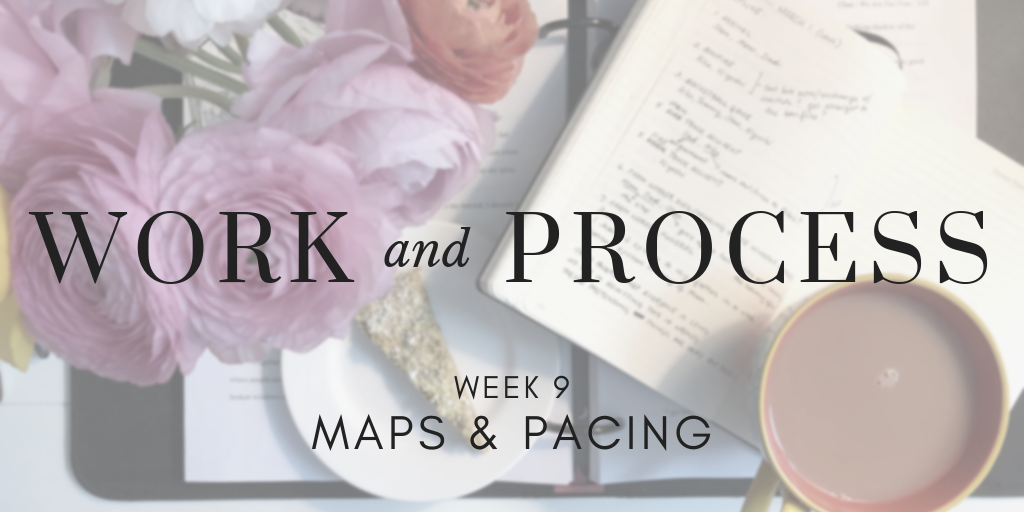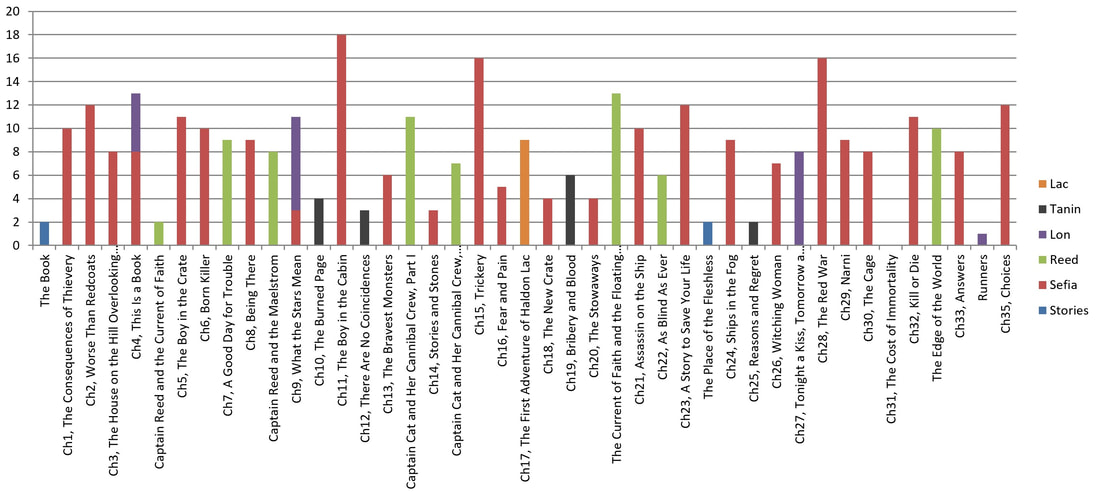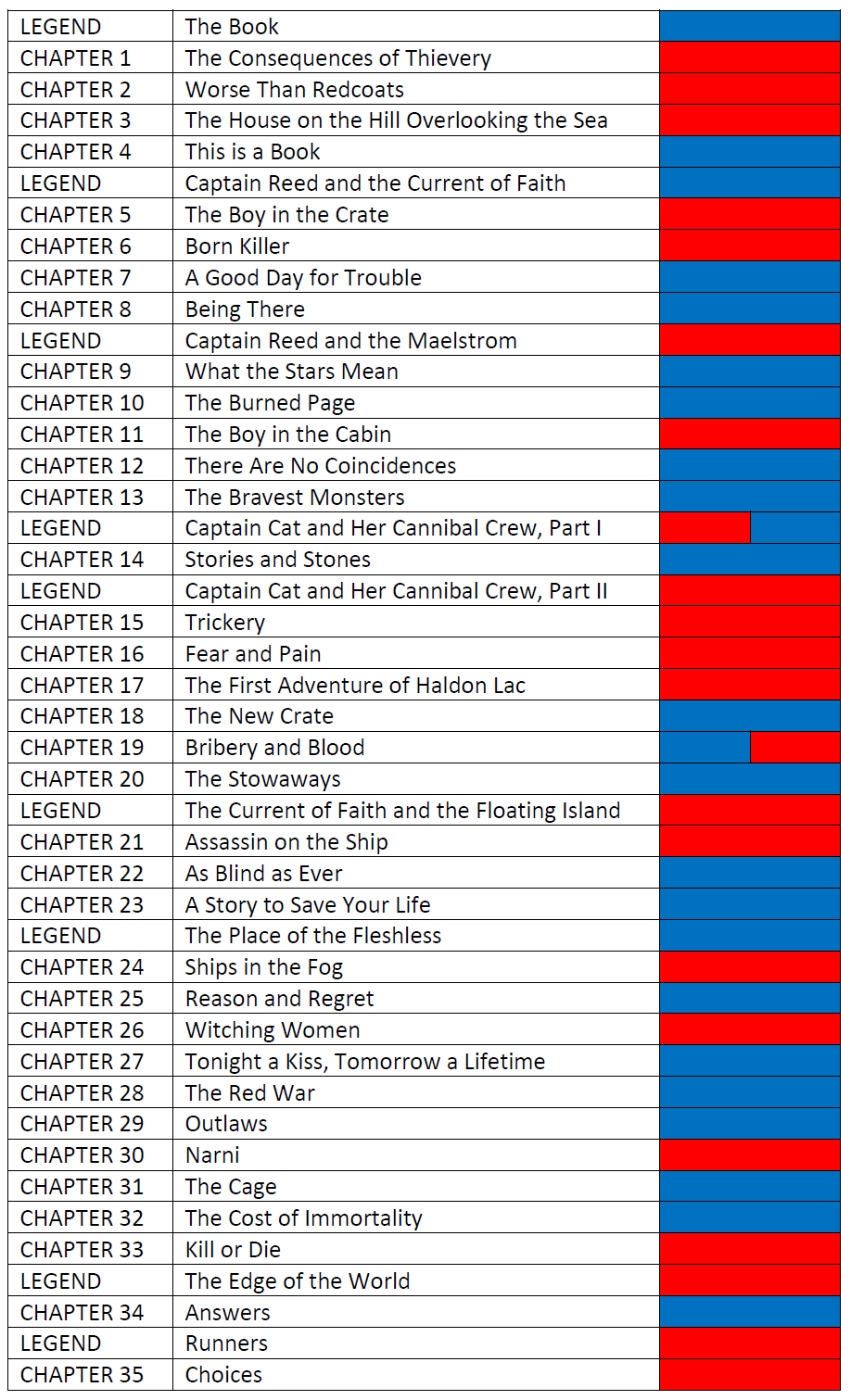|
During Week 5, I mentioned that I am a structure writer--I conceive of my projects first by their shape and only secondarily by their themes, characters, and plots. I think this is connected to the fact that I am a visual thinker. I have to see something to grasp it. This means I print out my drafts so I can view an entire page as I edit it. I make spreadsheets for my revision plans. I lay out my plots with index cards and sticky notes so I can take in the whole complex thing in a single glance. (I wonder if this means I’m also a tactile thinker, since I prefer working with objects that I can physically move around? Perhaps that's a meditation for another Work and Process!) Being a visual thinker also means that I incorporate a lot of maps and charts into my revision process. After I completed one of the many drafts of The Reader, for example, I charted the page count by chapter, like so (minor spoilers if you read the chapter titles): Along one axis, I listed all the chapters, including the legends we hear from the narrator and the passages Sefia reads in the books. Along the other, I tabulated the number of pages in each chapter, color-coded according to which character my close third-person narrator was focused on at the time. With my book laid out this way, I could see which chapters were extravagantly long and which which were skeletally short, indicating pretty clearly where I needed to examine my scenes for excess description, dialogue, or action, like Chapter 11, Chapter 15, and Chapter 28, which all had page counts well above the others. Color-coding each chapter by point-of-view character (at least, roughly--there are some chapters in there that are told from other perspectives) also allowed me to see the distribution of story lines across the whole book and make sure they were evenly woven together (mostly!). Or, in 2014, I was in the middle of the revision round of Pitch Wars, an online contest where unagented writers work one-on-one with more established authors, editors, and other industry professionals to revise their manuscripts, after which pitches and first pages are posted online for agents to review and request, if they so choose. I was struggling with the pacing, the forward movement, the ebbs and flows of tension and action, but I couldn’t figure out exactly where and how I needed to revise, so I made the following chart:: Again, I listed all the chapters. Then, I marked each chapter with a color: blue for a chapter primarily focused on talking, red for a chapter primarily focused on action.
These talking/action categories were something I came up with because I could feel most of the chapters pulling in one direction or another, but I don’t think they’re particularly insightful classifications. Talking chapters were dialogue-heavy. The characters were discussing what had just happened to them, usually in the previous chapter, making plans for what to do next, or using words to try to achieve their goals. Action chapters tended to be hikes, fights, explorations, or escapes--scenes where the characters were doing more than they were thinking or talking. In the years since I came up with this tool, though, I’ve also learned about scene/sequel patterns, which group scenes in a more thorough, purposeful way, but at the time I didn’t have that language or those organizing principles, so, well… talking/action it was! And, importantly, seeing my book laid out this way helped me to pinpoint areas that were just too conversation-heavy, like Chapters 12-14, Chapters 22-The Place of the Fleshless, and Chapter 27-29. In general, these are chapters where the characters were discussing what had just happened to them, making plans for what to do next, or using words to try to achieve their goals. So I went back in, to those blocks where three or more chapters were conversation-centered, and I revised them to cut the extended dialogue pieces, add more knife fights, and turn those blue chapters red! Ultimately, I love shapes and structures, but sometimes I need a little help to understand what I’m doing and how to do it better, which means I have more charts and things to share with you soon! “Maps” will be a recurring topic on Work and Process, as I reveal how I approach other aspects of storytelling, such as stakes, the hero’s journey, and telling a story with multiple points of view. Until next time, fellow storytellers and cartographers. Next week: ART AND SUFFERING. I think it’s hard being an artist for a number of reasons. Putting your dreams and your heart out there for the consuming public. Carrying worlds inside you. Forcing and contorting your process into weird and painful shapes in order to meet your deadlines. But, next week, I’d like to push back against this idea that artists necessarily have to suffer for their art. Necessarily have to be alone. Necessarily have to be in pain in order to make something great. Dispel some myths with me next Sunday at tracichee.com and/or post your own responses with the hashtag #workandprocess. Abracadabra! <3 Work and Process is a year-long journey of exploring and reflecting on the artistic process, craft, and working in a creative field. Each Sunday, I’ll post some thoughts, wonderings, explanations, and explorations on writing and creativity, and by the end of it, I hope to have 52 musings, examinations, meanderings, discoveries, bits of joy or inquisitiveness or knowledge to share. In each post, I’ll also include a topic for the following week, so if you happen to be inspired to question/wonder at/consider your own work and process, you’re welcome to join me. We’ll be using the #workandprocess hashtag across all social media platforms, and I hope we find each other to learn and connect and transform on our creative wanderings. Comments are closed.
|
ARCHIVES
February 2024
CATEGORIES |




 RSS Feed
RSS Feed